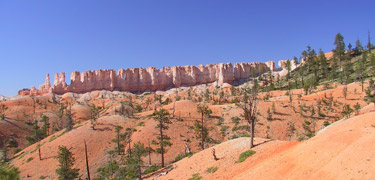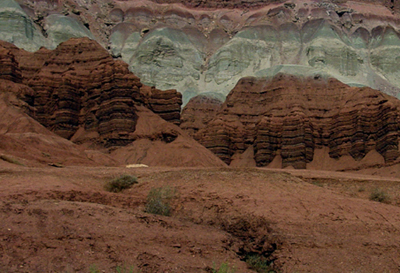
Courtesy National Parks Service
Straddling the four corners region is a massive geologic province known as the Colorado Plateau. Varying from 5 to 10,000 feet in elevation the region covers an area even larger than Utah, and is composed of thick horizontal layers of sedimentary rock. Wind and water have whittled Plateau rock into dramatic cliffs and steps as well as fanciful domes, towers, turrets, and arches. A predominance of red bed deposits in the central area of the Plateau has prompted the nickname “red rock country.”
So what’s behind these spectacular red hues? The color of rock is primarily influenced by trace minerals. The red, brown, and yellow colors so prevalent here result from the presence of oxidized iron–that is iron that has undergone a chemical reaction upon exposure to air or oxygenated water. The iron oxides released from this process form a coating on the surface of the rock or rock grains containing the iron.

for some of the reddish rock found
in Arches National Park.
Courtesy USGS
Just think of what happens to a nail when you leave it outside. Upon prolonged exposure, the iron in the nail oxidizes and rust is formed as a coating on the surface of the nail. So basically what we have in red rock country is a lot of rusting sandstones and shales. Hematite is an especially common mineral form of iron oxide in Utah, the name coming from the Greek word “heama” or red blood. It only takes a tiny bit of hematite make a lot of red rock.
Certain rock formations in Utah are particularly well-known for their beautiful reddish colors. The Permian Period gave us Organ Rock shale which caps the buttes and pinnacles of Monument Valley. The deep ruddy browns of the Moenkopi formation were formed in the Triassic. In the early Jurassic, eastern Utah was a vast sea of sand with wind-blown dunes. These dunes became the red bed deposits of the Wingate Formation which today forms massive vertical cliffs. Entrada sandstone, from the late Jurassic, forms the spectacular red, slickrock around Moab.

in Capitol Reef National Park.
Courtesy USGS
So now you know what I’m thinking of when I hear Utah referred to as a Red State. I’m picturing the extraordinary splendor of the red, orange and rust- brown rocks that help to form the massive geologic layer cake in the south and east of our state.
For Wild About Utah I’m Holly Strand.
Utah, the Red State-Credits:
Photos: Courtesy National Park Service, https://www.nps.gov/brca/ and
United States Geological Survey (USGS)https://www.usgs.gov/
Text: Holly Strand
Utah, the Red State-Additional Reading:
Chan,Marjorie A. and William T. Parry Rainbow of Rocks . Public Information Series 77. Utah Geological Survey. https://geology.utah.gov/online/pdf/pi-77.pdf (Accessed July 2008)
Geology Underfoot in Southern Utah by Richard L. Orndorff, Robert W. Wieder, and David G. Futey, Missoula, MT Mountain Press Publishing Company, 2006, https://mountain-press.com/item_detail.php?item_key=366
Chronic, Halka. Roadside Geology of Utah. Missoula, MT Mountain Press Publishing Company, 1990 https://mountain-press.com/item_detail.php?item_key=48
Fillmore, Robert, The Geology of the Parks, Monuments and Wildlands of Southern Utah, University of Utah Press, 2000, https://content.lib.utah.edu/cdm4/item_viewer.php?CISOROOT=/upcat&CISOPTR=1328
